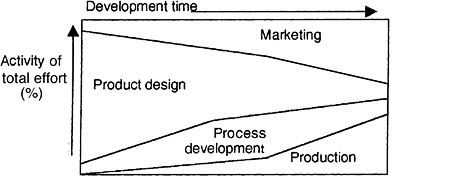FOOD
PRODUCT DEVELOPMENT
Mary Earle, Richard Earle and Allan Anderson |
| Loading
|
|
||||
|
|
Part
2, Chapter 3
The product development process 3.2 Product design and process development The themes for Stage 2: product design and process development, are integration, creativity, systematic planning and monitoring.
Food product development is process-intensive, the characteristics of the product are highly constrained by the processing. Therefore the process and the product are developed together. This tight integration of process development and product design, called concurrent or simultaneous engineering, is becoming more important because of the time and cost constraints on getting the product to the market (Fox, 1993; Stoy, 1996). Jonsdottir et al. (1998), reviewing concurrent engineering in seafood companies, defined the overall goal of concurrent engineering as quality, cost, schedule, product user requirements and reduction of the time the product takes to reach the market. They emphasised the information technology applications in product models, in particular the knowledge of the product's functional and structural characteristics, and the development of a system model that secures the integration and reuse of knowledge in the different stages of the product development process. The concurrent design also integrates with marketing and production (Hollingsworth, 1995) as shown in Fig. 3.7.  Fig. 3.7 Integration in product development. Often in incremental development, the production plant is already in place, and the product has to be designed for that plant and the process can only be varied between narrow limits. The company's identity or company's image is the sum of product design, communications design and environment design (Blaich and Blaich, 1993). Communication design directly supports the product in the marketplace with branding, packaging, advertising and promotion; therefore it needs to be closely integrated with the product design. Environment design is a concept that is not always considered, but it does influence the product and communications design, and the final acceptance of the new product. If a company wants to communicate the appropriate perception about its products, it must concern itself with the entire milieu surrounding the products, both inside and outside the company. If the company image diffused to the employees and the customers is quality, the new product is also seen as quality; if it is fresh and innovative, the product will be recognised as excitingly new. The company and distribution environments give the company and its new products an 'image' to the customers. Therefore product design needs to be integrated with communication and environment design throughout the design process. |
|
 |